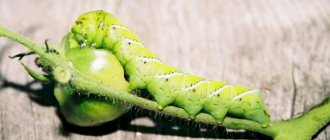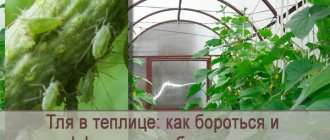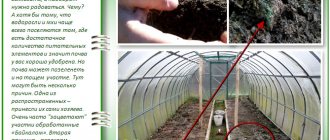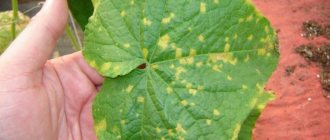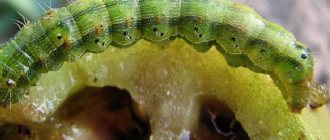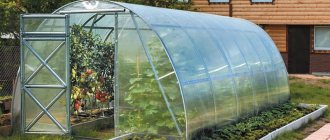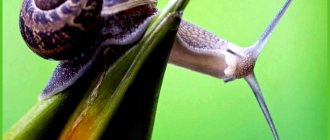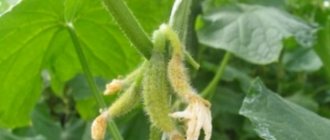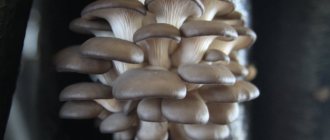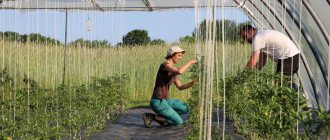The topic of how to deal with whiteflies in a greenhouse is of interest not only to novice gardeners, but also to people who have extensive experience in plant growing. The rapid reproduction of the insect leads to the fact that the plant does not receive enough moisture and useful components and begins to wither. There are many ways to get rid of it, from manual collection or spraying with pesticides, to setting up traps or introducing antagonistic insects (predators).
Tomatoes affected by whitefly Source stopklopu.com
How to detect the presence of whiteflies
The insect has an original appearance, so it is simply impossible to confuse it with others:
- The body is light green, and the wings are milky white.
- Superficially it resembles a moth, but has a more elongated body, 1-3 mm long.
- Whitefly larvae may have a yellowish or gray tint, and their mobility depends on the period of the life cycle.
This is what a whitefly looks like Source wp.com
Tomatoes affected by whitefly Source stopklopu.com
Mechanical method
The whitefly is washed away with a strong stream of water. After this, you need to prepare a soap solution, 100 g of laundry soap per 0.6 liters of warm water. Using a sponge, you need to wipe each leaf with this solution, washing off all the larvae. Many gardeners use tar soap to repel insects with a specific smell.
This method is suitable for small greenhouses. For larger areas the effect of this method will be minimal.
How to prevent it from appearing
Actions related to the fight against whitefly should begin in the fall, immediately after harvest. To do this, you need to completely remove plant debris from the greenhouse. This way you will reduce the likelihood of the pest getting into the ground, where it can easily overwinter and wait until spring.
In the spring, at the seedling propagation stage, do not place seedlings next to home crops. The whitefly loves geraniums and pelargonium, from where it moves to young shoots, and with them ends up in the greenhouse. Therefore, try to ensure that indoor flowers and seedlings of tomatoes, cucumbers, and peppers are located on different windowsills.
Why I decided to fight whiteflies in the greenhouse
The adult whitefly can be confused with the beautiful snow-white moth. But this pretty and defenseless, at first glance, creature is a serious enemy of the gardener. The insect, like a small pump, sucks out the cell sap of various greenhouse plantings - tomatoes, cucumbers, cabbage.
The vital activity of the pest inhibits the development of plants. The seedlings stop forming green mass and do not bloom. Fruiting is unfriendly, and the harvest is small and of poor quality. When infested by whiteflies, the plant may die from a lack of nutritious cell sap.
Greenhouses are a favorable place for pests to live and reproduce: warmth, high humidity, and an abundance of lush greenery. During a 30-day life, one female manages to lay 100-150 eggs. After 20-40 days, the larvae will already turn into adult voracious butterflies.
The cubs themselves also have a good appetite. The danger of larvae is that they are invisible to the naked human eye. The length of their bodies does not exceed 0.3-0.9 mm. Like adults, they feed on cell sap. They lead a hidden lifestyle - the female lays eggs on the inner surfaces of leaf blades.
whitefly on vegetables
Fighting methods
The greenhouse whitefly is a frequent enemy of gardeners in central Russia. There are a lot of methods to combat insects, let's look at the most effective of them using specific examples.
Whitefly and its larvae Source vseprodachu.ru
Manual method
The manual or mechanical method of controlling whiteflies refers to the collection of insects and clusters of eggs and larvae (if there are small numbers of them). If the concentration of moths is higher, they can be knocked down with a stream of water from a watering hose. After the plants are cleaned, each leaf (on both sides) is wiped with a solution of laundry soap (proportions 1 to 6). At higher concentrations, a household vacuum cleaner can be used. With its help, you can not only knock down harmful tenants, but also spray soap concentrate.
How to deal with whitefly Source vosaduly.ru
Healthy! This method is considered the most time-consuming and least effective. It is used at the early stage of colonization and in the presence of a small number of plantings.
Advantages and disadvantages of insecticides
Advantages:
- A large selection of drugs on the market at different prices and different mechanisms of action on pests;
- Most chemicals effectively destroy both adult pests and their offspring;
- Some preparations have fumigator properties, that is, they form a protective cloud around the plant.
Flaws:
- Some chemicals can cause serious harm to the natural enemies of whiteflies;
- When using agrochemicals, you must follow safety rules and wear a mask, goggles and gloves;
- Some insecticides are quite expensive.
Biological countermeasures
Another no less effective, but completely environmentally friendly way to combat it is the use of other insects - competitors. By planting just a few representatives of one species or another, you can completely disrupt the pest plantation without the risk of harming the plantings. Below are some of the most inveterate enemies.
A bug eating whiteflies Source mrdachnik.com
Macrolophus caliginosus is a voracious predator bug that feeds on many insect pests. It is used as one of the highest quality and proven methods of combating aphids, whiteflies, spider mites, and tomato leafminer moths. It is advisable to populate them every 2 weeks for a month. After this, the insects will take root and begin to independently maintain their population.
The most beautiful defender of your greenhouse Source fotokto.ru
The ladybug is one of the main enemies of many insect pests in garden areas. It feeds on whiteflies, aphids, scale insects, small caterpillars, spider mites, Colorado potato beetle larvae and many enemies of the gardener.
A parasitic insect that destroys pest larvae Source newogorod.ru
Encarzia is one of the most effective opponents of our pest. Belongs to the category of parasitic parasitic parasites, the larva of which pupates in the host's shell. About a week before planting the seedlings, place 3-4 bags of the parasite in the greenhouse. The females will independently find the whitefly and lay their embryos in its body, which will destroy their host.
Interesting! Common tansy planted in a greenhouse nearby provides good protection against whiteflies.
Yellow tansy is a gardener's friend Source fs3.fotoload.ru
Harm caused
By attaching to leaves and feeding on their juices, the pest slows down the growth of the plant and deprives it of strength for further development. First, subtle transparent scales appear on the lower part of the leaves; traces of a sticky and shiny coating are visible in different parts of the plant - secretions of insect waste products. If you shake an infected bush of tomato or cucumber seedlings, a whole swarm of white moth flies will appear above the garden bed. Then the leaves turn yellow and curl, and dark spots appear on the fruits. As a result of insufficient nutrition, the plant dies.
You need to try to get rid of whiteflies on tomatoes in a greenhouse when the first signs of infection appear
The creation of the most comfortable conditions for pests is facilitated by heat (air temperature about 22 ℃) and a high level of humidity (from 65%).
It is important to understand that both adult individuals and their larvae pose a danger to vegetable crops. Together they suck out juices in large quantities and secrete a lot of liquid substance, the so-called shiny coating. Sooty fungi often appear on the secretions left by pests in the form of dark spots.
How to properly prepare a greenhouse for wintering in the fall - useful tips
According to reviews from experienced gardeners, it is recommended to take the soil out of the greenhouse, put it in a place marked on the plot, in a layer of 200 mm, sprinkle it with bleach, dig it up, and leave it to freeze out for the winter. If you plan to bring in new soil, then the old soil can be evenly scattered around the garden.
If the greenhouse is heavily infected with infections, if the plants are often sick or destroyed by harmful insects, in the fall the soil should be etched with a 2.5% formaldehyde solution. The method is unsafe, but effective, it helps to destroy even larvae and insect eggs. The substance is very harmful, so before you treat the soil in the greenhouse with formaldehyde in the fall, put on gloves and a respirator. Pour the solution into a spray bottle and spray 1 liter of formaldehyde per 1 m2 of beds.
When the chemical treatment of the soil in the greenhouse in the fall is completed, the room is closed and left for 5-10 days to maximize the impact of the drugs on pests and pathogenic infections. Next, the soil is ventilated, fertilized, fed, and its structure is improved:
- add a layer of ash;
- add fertilizers, the type depends on the crop;
- thoroughly water with a solution of potassium permanganate;
- clean sand, peat, compost are scattered on top; you can fertilize with sawdust and manure;
- In the fall, the beds are dug up to the depth of a spade, the soil is thoroughly loosened, and the remaining roots are selected.
Processing of the greenhouse in the fall should take place at a temperature of 10-15 ° C in a protective suit
We have given detailed instructions on how and with what to wash a polycarbonate greenhouse in the fall, but these measures are not enough to prepare for winter
It is also important to strengthen the structure, insulate it if necessary, and provide lighting.
If plants will be planted in the greenhouse for the winter in the fall, the foundation should be insulated with polystyrene foam boards, wooden panels, covered with film, and a mound of earth should be made. It is recommended to install a second layer of film, thin polycarbonate, inside. The air gap between the layers retains heat well.
The photo shows an example of insulating a structure in the fall
In regions with a harsh climate, you should consider heating the greenhouse in the fall: stove, electric, water. The easiest way to install ultraviolet heaters or fan heaters. For the full development of plants, do not forget to provide additional lighting; the set of lamps for lighting must completely duplicate the solar spectrum. To avoid damage to the greenhouse from heavy snow loads, vertical supports should be placed inside every 1.5-2 m.
Carrying out preventive work
Whitefly is a dangerous pest that many people are unable to get rid of. The means at hand don’t always help, and you don’t want to use chemicals. Preventative measures play a good role in preventing the appearance of harmful insects.
- In the fall, after harvesting, you need to collect all the garbage and burn it. Dig up the soil. Disinfect all surface parts with lime. Wash the glass with a solution containing soap.
- If possible, the greenhouse should be opened so that it freezes. Frosts will help to cope with insect larvae in the soil.
- In the spring, you need to disinfect the greenhouse with copper sulfate. But not more often than once every three years. 200 g of vitriol are diluted per 10 liters of water. Treatment must be carried out no later than a month before planting.
- You should not plant plants close to each other; you need to follow the planting pattern.
- After planting seedlings, constant ventilation of the greenhouse is necessary. This will reduce the risk of disease.
Many harmful insects spoil the life of gardeners and destroy crops. One of these insects is the whitefly, which is very difficult to get rid of. She has good immunity, so an integrated approach is required. Carrying out preventive measures together with folk remedies or chemicals will show excellent results and help protect the crop.
Traps
This method refers to variants of the mechanical method of exterminating harmful insects. Special traps are purchased, which are bright plates with an adhesive backing. You can make a trap yourself; you will need a strong base, it can be thick yellow cardboard or plywood painted with yellow paint. Anything bright attracts insects. The prepared base must be covered with an adhesive mass, which can be prepared as follows: rosin, castor oil and petroleum jelly must be mixed in a container. Add honey and mix until smooth. Apply the mixture to the base and hang it in the greenhouse, one trap per 10 square meters. meters.
For long-term use, you can use something stronger than a sheet of cardboard as a basis; they can be washed with warm soapy water and used again.
Fumigator
Many summer residents get rid of whiteflies using fumigators, which are used against mosquitoes and flies. To do this, you just need to plug the fumigator with the plate or liquid into a power outlet. Before turning on the fumigator, you must close all windows and doors. Unfortunately, along with harmful insects, beneficial insects also die.
